Arnold, Henry Harley "Hap"
- Date of birth:
- June 25th, 1886 (Gladwyne/Pennsylvania, United States)
- Date of death:
- January 15th, 1950 (Sonoma/California, United States)
- Buried on:
- Arlington National Cemetery
Plot: 34. Grave: 44-A. - Nationality:
- American
Biography
Henry Harley "Hap" Arnold was taught to fly by the Wright Brothers in 1911. Arnhold was then assigned to the aviation division of the Signal Corps. He was Chief of the Air Corps from 1938 to 1940, when he became Deputy Chief of Staff Army for Air Matters. Arnhold was Chief of Staff of the U.S. Army Air Forces throughout World War II and was made General of the Army in 1944. After the creation of the Air Force as a separate department Arnold was made General of the Air Force in June 1949.
Do you have more information about this person? Inform us!
- Rank:
- Lieutenant Colonel
- Awarded on:
- 1937
War Department, General Orders No. 1
- Period:
- Second World War (1939-1945)
- Rank:
- Lieutenant General
- Unit:
- Chief of Staff, Headquarters, U.S. Army Air Forces
- Awarded on:
- October 1942
"For exceptionally meritorious and distinguished service in the performance of duties of great responsibility as Chief of the Air Corps from 29 September 1938 to 31 May 1941, as Deputy Chief of Staff for Air from 29 November 1940 to 8 March 1942, and as Chief of the Army Air Forces from 20 June 1941 to 8 March 1942. He performed the duties required by the office in a superior manner during the most strenuous and trying period in the history of the air arm. During this period, an Air Corps Program of Expansion and Procurement was inaugurated whereby the personnel of the Air Forces was increased in excess of a thousand per cent and the number of aircraft increased proportionately. A program of expansion and procurement of this magnitude demanded comprehensive planning, its execution required outstanding ability, foresight, and leadership, all of which were exhibited by General Arnold in a high degree. He impressed this high quality of leadership, so vitally needed during this period."
War Department, General Orders No. 51
War Department, General Orders No. 51
- Period:
- Second World War (1939-1945)
- Rank:
- General
- Unit:
- Chief of Staff, Headquarters, U.S. Army Air Forces
- Awarded on:
- March 1943
- Period:
- Second World War (1939-1945)
- Rank:
- General
- Unit:
- Chief of Staff, Headquarters, U.S. Army Air Forces
- Awarded on:
- 1943
- Period:
- Second World War (1939-1945)
- Rank:
- General of the Army (0)
- Awarded on:
- October 25th, 1945
War Department, General Orders No. 92 (Bronze Oak Leaf Cluster in lieu of a Second Award of the Army Distinguished Service Medal)
- Period:
- Second World War (1939-1945)
- Rank:
- General of the Army (0)
- Awarded on:
- June 26th, 1946
G.O. 61 (Second Bronze Oak Leaf Cluster in lieu of a Third Award of the Army Distinguished Service Medal)
- Period:
- Second World War (1939-1945)
- Rank:
- General of the Army (0)
- Unit:
- U.S. Army Air Force
- Awarded on:
- December 14th, 1946
Royal decree no. 2
- Period:
- Second World War (1939-1945)
- Rank:
- General
- Period:
- Second World War (1939-1945)
- Rank:
- General of the Army (0)
- Period:
- Second World War (1939-1945)
- Period:
- Second World War (1939-1945)
- Period:
- Second World War (1939-1945)
- Period:
- Second World War (1939-1945)













